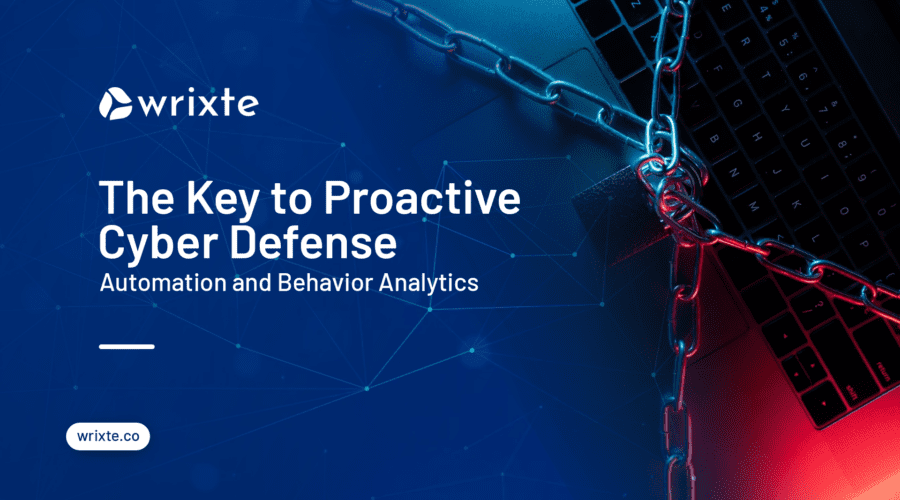Cybersecurity is an ever-evolving field, and as the threat landscape continues to expand, organizations must find new ways to enhance their defense strategies. Proactive cyber defense has emerged as a critical approach to staying ahead of malicious actors and preventing potential attacks. Two key components of proactive cyber defense are automation and behavior analytics.
By leveraging these innovative technologies, organizations can not only detect and respond to threats more effectively but also anticipate and mitigate potential risks. In this blog, Wrixte will explore the importance of automation and behavior analytics in unlocking proactive cyber defense and discuss their benefits and challenges in the ever-changing cybersecurity landscape.
Understanding Automation and Behavior Analytics
Traditional cyber defense approaches, such as reactive measures like firewalls and antivirus software, are no longer sufficient in protecting sensitive data and critical infrastructure.
Automation allows organizations to streamline and simplify their security operations. By automating routine tasks and repetitive processes, security teams can free up valuable time and resources to focus on more critical areas. Automation can help with a wide range of tasks, including threat hunting, incident response, and vulnerability management. Additionally, automation can help improve consistency and accuracy in security operations, minimizing the risk of human error.
Behavior analytics, on the other hand, focuses on understanding and detecting abnormal or suspicious behavior within an organization’s network or systems. By analyzing patterns and anomalies in user behavior, behavior analytics can identify potential threats or malicious activities that may go unnoticed by traditional security measures. This proactive approach can help organizations detect and prevent insider threats, identify compromised user accounts, and mitigate the impact of sophisticated attacks.
Benefits of Integrating Automation and Behavior Analytics
Integrating automation and behavior analytics into a proactive cyber defense strategy offers several benefits for organizations:
Real-time threat detection: Automated security tools and behavior analytics enable immediate identification of potential cyber threats by continuously monitoring network traffic and user behavior.
Reduced response time: Automation allows for quick analysis of vast data sets, leading to faster identification of attack vectors and abnormal user behavior.
Improved accuracy and efficiency: Automation eliminates human errors, ensuring consistent and accurate security operations.
Enhanced situational awareness: Continuous monitoring through automation provides organizations with a comprehensive understanding of their security posture and deviations from normalcy.
Resource optimization: Automating routine tasks frees up security teams to focus on more complex and strategic activities, improving operational efficiency.
Continuous monitoring and threat hunting: Automation enables proactive threat hunting by continuously analyzing network traffic, log data, and user behavior.
Alignment with compliance and regulatory requirements: Automation helps organizations generate comprehensive reports and audit trails, ensuring compliance with regulations and detecting insider threats.
Use Cases of Proactive Cyber Defense in Action
Thwarting Advanced Persistent Threats (APTs) with Automation and Behavior Analytics: A sophisticated APT attack can persist for months without detection. By combining automated threat hunting and behavior analytics, security teams can identify subtle indicators of APTs, such as unusual data exfiltration patterns or lateral movement within the network, and respond promptly to neutralize the threat.
Detecting Insider Threats through Behavioral Analysis and Automated Alerts: Insiders with malicious intent pose a significant risk to an organization’s security. Behavior analytics can detect changes in employees’ behavior, such as accessing unauthorized resources or working unusual hours, while automated alerts can trigger investigations and containment actions.
Proactive Defense against Ransomware Attacks: Automated systems can monitor network activity for signs of ransomware infection, such as rapid file encryption, while behavior analytics can identify suspicious file access patterns. Together, they can detect and stop ransomware attacks before significant damage occurs.
Addressing Concerns and Misconceptions
While automation and behavior analytics significantly enhance cyber defense capabilities, human expertise remains invaluable. Cybersecurity professionals are essential for fine-tuning the automated systems, interpreting the analytics, and making critical decisions in complex situations.
Moreover, privacy and ethical considerations must be at the forefront of any proactive cyber defense strategy. Data collection and analysis should be carried out responsibly, adhering to legal and regulatory requirements, and respecting individuals’ privacy rights.
Debunking common myths, such as the fear of “robots replacing humans,” is vital to gaining support for automation and behavior analytics adoption. Instead of replacing human efforts, these technologies empower cybersecurity teams to become more effective in combating cyber threats.
Conclusion
In conclusion, as we look towards the future of proactive cyber defense, it is clear that the integration of automation and behavior analytics will continue to play a crucial role in safeguarding organizations against evolving cyber threats. The advancements in artificial intelligence and machine learning will enable organizations to analyze vast amounts of data in real-time and automate incident response processes.
Predictive analytics will allow organizations to predict potential future threats and take preemptive measures to prevent them. Integration with threat intelligence platforms will provide real-time information on the latest threats, enabling organizations to adjust their defense strategies accordingly.
Behavior-based anomaly detection will become more sophisticated, helping organizations identify insider threats and unauthorized access. Automated threat response and orchestration platforms will minimize response time and integrate with existing security tools. Continuous monitoring and adaptive defenses will ensure that organizations stay resilient against evolving threats.
Take the first step towards a fortified cybersecurity strategy by integrating automation and behavior analytics. Embrace innovation and stay ahead of cyber threats with Wrixte’s state-of-the-art solutions.
